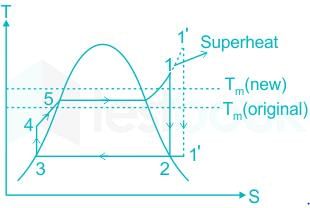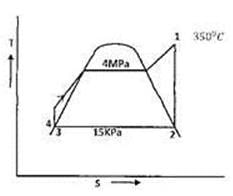Test: Introduction to Power Plant & Steam Cycle - 1 - Mechanical Engineering MCQ
20 Questions MCQ Test - Test: Introduction to Power Plant & Steam Cycle - 1
A thermoelectric engine which consists of two dissimilar electric conductors connected at two junctions maintained at different temperatures, converts
A thermal electric power plant produces 1000 MW of power. If the coal releases 900 x 107 kJ/h of energy, then what is the rate at which heat is rejected from the power plant?
The efficiency of superheat Rankine cycle is higher than that of simple Rankine cycle because
In a Rankine cycle, regeneration results in higher efficiency because
Consider an actual regenerative Rankine cycle with one open feed water heater. For each kg steam entering the turbine, If m kg steam with a specific enthalpy of h1 is bled from the turbine, and the specific enthalpy of liquid water entering the heater is h2, then h3 specific enthalpy of saturated liquid leaving the heater Is equal to
In a steam power plant operating on the Rankine cycle, steam enters the turbine at 4 MPa, 350°C and exits at a pressure of 15 kPa. Then it enters the condenser and exits as saturated water. Next, a pump feeds back the water to the boiler. The adiabatic efficiency of the turbine is 90%. The thermodynamic states of water and steam are given in the table
h is specific enthalpy, s is specific entropy and v the specific volume; subscripts f and g denote saturated liquid state and saturated vapour state
The net work output (kJ kg-1) of the cycle is
In a steam power plant operating on the Rankine cycle, steam enters the turbine at 4 MPa, 350°C and exits at a pressure of 15 kPa. Then it enters the condenser and exits as saturated water. Next, a pump feeds back the water to the boiler. The adiabatic efficiency of the turbine is 90%. The thermodynamic states of water and steam are given in the table.
h is specific enthalpy, s is specific entropy and v the specific volume; subscripts f and g denote saturated liquid state and saturated vapour state.
Heat supplied (kJ kg-1) to the cycle is
For a given set of operating pressure limits of a Rankine cycle, the highest, efficiency occurs for
A thermal power plant operates on a regenerative cycle with a single openfeed water heater, as shown in the figure. For the state points shown, thespecific enthalpies are: h1 = 2800 kJ/kg and h2 = 200 kJ/kg. The bleed to thefeed water heater is 20% of the boiler steam generation rate. The specificenthalpy at state 3 is
For two cycles coupled in series, the topping cycle has an efficiency of 30%and the bottoming cycle has an efficiency of 20%. The overall combinedcycle efficiency is
Consider the following processes:
1. Constant pressure heat addition
.2. Adiabatic compression.
3. Adiabatic expansion
.4. Constant pressure heat rejection.
The correct sequence of these processes in Rankine cycle is::
In a Rankine cycle, with the maximum steam temperature being fixed from metallurgical considerations, as the boiler pressure increases
In which one of the following working substances, does the relation  hold good if the process takes place with zero heat transfer?
hold good if the process takes place with zero heat transfer?
Consider the following for a steam turbine power plant:
1. Reduction in blade erosion.
2. Increase in turbine speed.
3. Increase in specific output.
4. Increase in cycle efficiency.
Which of the above occur/occurs due to reheating of steam?
Blade erosion in steam turbines takes place
Consider the following statements The reheat cycle helps to reduce
1. Fuel consumption
2. Steam flow
3. The condenser size
Which of these statements are correct?
Consider the following statements regarding effects of heating of steam ina steam turbine:
1. It increases the specific output of the turbine
2. It decreases the cycle efficiency
3. It increases blade erosion.
4. It improves the quality of exit steam?
Which of these statements are correct?
Employing superheated steam in turbines leads to
Which one of the following is correct?In ideal regenerative cycle the temperature of steam entering the turbine is same as that of
In a steam power plant, the ratio of the isentropic heat drop in the primemover to the amount of heat supplied per unit mass of steam is known as



 Rankine cycle with superheating is shown in the figure.
Rankine cycle with superheating is shown in the figure.


















